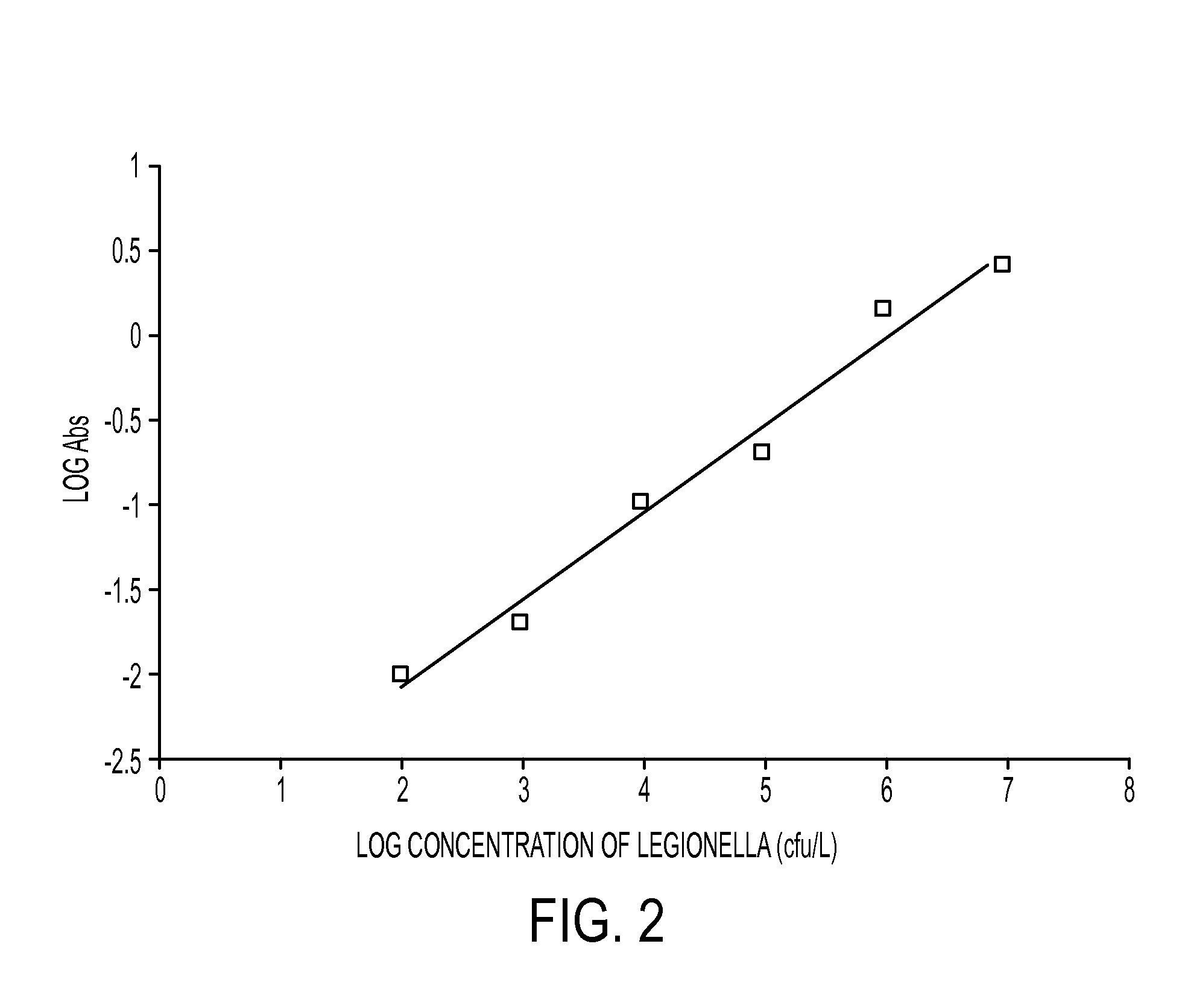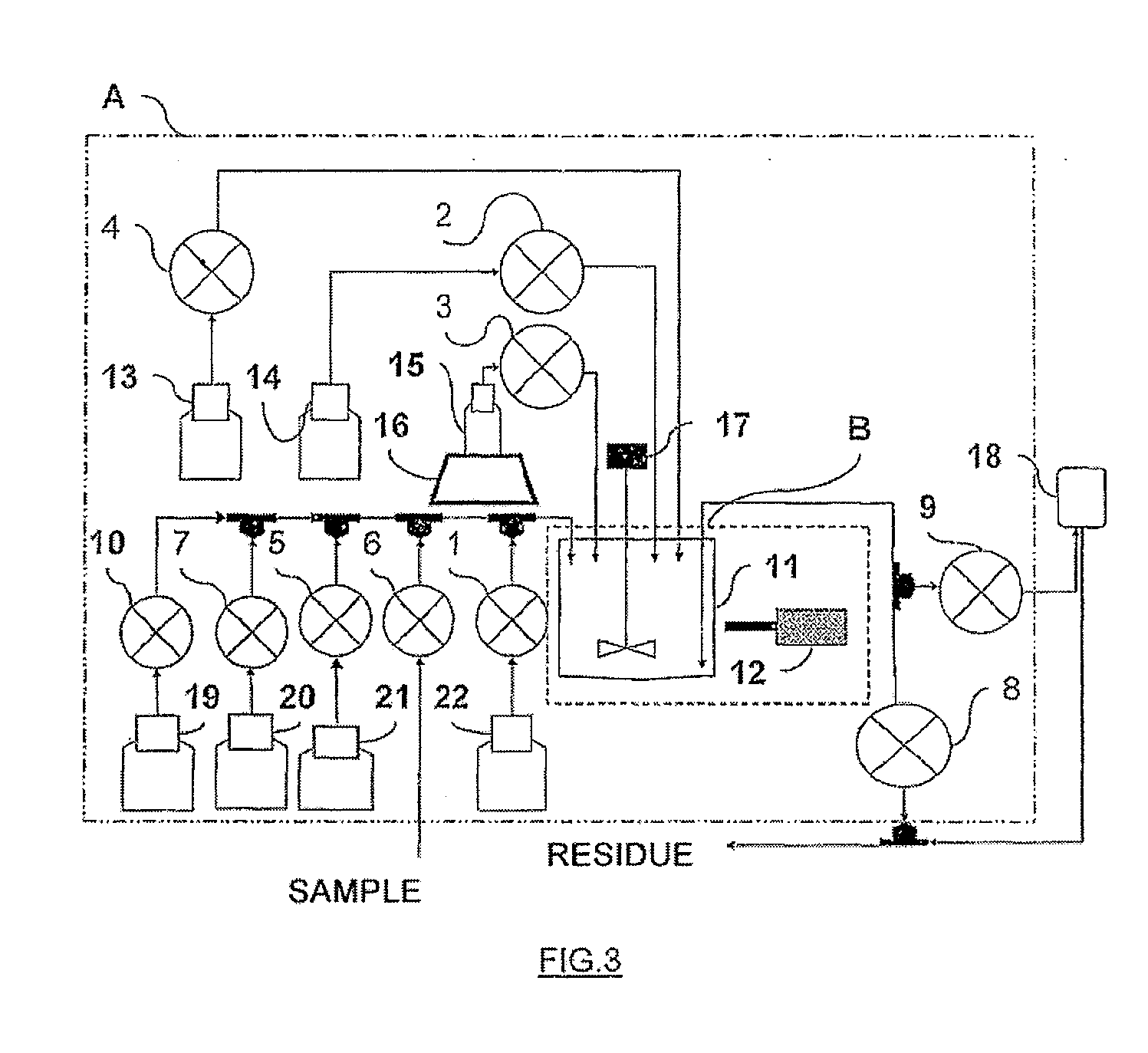Rapid process for detection of microorganisms with magnetic particles
a technology of magnetic particles and microorganisms, which is applied in the direction of biochemistry equipment and processes, biochemistry apparatus and processes, material testing goods, etc., to achieve the effects of improving detection efficiency, improving detection efficiency, and increasing sample signal
- Summary
- Abstract
- Description
- Claims
- Application Information
AI Technical Summary
Benefits of technology
Problems solved by technology
Method used
Image
Examples
example 1
Detection of Legionella in a Sanitary Water Sample
[0231]Superparamagnetic particles of polystyrene (mean diameter of 0.9 μm, 45.7% magnetic pigment-Estapor Merck France) which have carboxyl groups on their surface are used. An anti-Legionella polyclonal antibody is immobilized on these particles. The immunomagnetic particles were incubated in a 25 mM phosphate buffer solution at pH 7.0 with 1% BSA for 12 hours, under gentle stirring. The resulting immunomagnetic particles were suspended in a 1 / 40 ratio in a 150 mM phosphate buffer solution containing 10% BSA, 1.0% Tween 20, 0.01% thimerosal, and 0.1% sodium azide. The final suspension of immunomagnetic particles is deposited in a portable apparatus for in situ analysis, similar to that which is shown in FIG. 1 and described above.
[0232]With the magnet away from the cuvette, a volume of 1.0 ml of the suspension of immunomagnetic particles is deposited inside the cuvette, and then a volume of 10.0 ml of water sample directly from of a...
example 2
Quantitative Analysis of Industrial Water
Cooling Towers and Waste Water
[0242]According to the process provided in the present invention in Example 1, two types of water samples were analyzed: samples from cooling towers and samples from waste water. For each type of sample, concentration of Legionella is determined by means of the plate culture, by means of polymerase chain reaction (PCR) and the analysis is performed by the method of the present invention, obtaining the reading of the absorbance at 550 nm. The volume of each sample assayed with the method of the invention is 10.0 ml and the samples were not pretreated.
[0243]As can be observed in FIG. 14, the obtained results indicate a high degree of consistency between the concentration of Legionella in the sample and the absorbance reading at 550 nm for the two assayed types of sample.
[0244]Accordingly, the method provided by the present invention allows obtaining an reliable estimation of the concentration of Legionella in diffe...
example 3
Quantification of Legionella by Means of an Automated Biosensor
[0245]This example presents the results obtained for sanitary water samples with different concentrations of Legionella, with 7 replicas per sample, by means of using the automated biosensor equipment described (FIG. 3) for the on-line monitoring of the concentration of Legionella in water based on using disposable aliquots of anti-Legionella immunomagnetic particles.
[0246]Each measurement cycle comprises the analysis of a blank and the analysis of a sample, and the corresponding signals are recorded by the automated biosensor (FIG. 4). The absorbance value resulting from subtracting the signal of the blank from the signal of the sample has a high correlation with the concentration of Legionella in the sanitary water sample (coefficient of correlation r=+0.99) (FIG. 2).
[0247]As shown in FIG. 5, the results obtained by means of the culture method and the method provided in the present invention for the automated biosensor...
PUM
| Property | Measurement | Unit |
|---|---|---|
| diameter | aaaaa | aaaaa |
| diameter | aaaaa | aaaaa |
| diameter | aaaaa | aaaaa |
Abstract
Description
Claims
Application Information
 Login to View More
Login to View More - R&D
- Intellectual Property
- Life Sciences
- Materials
- Tech Scout
- Unparalleled Data Quality
- Higher Quality Content
- 60% Fewer Hallucinations
Browse by: Latest US Patents, China's latest patents, Technical Efficacy Thesaurus, Application Domain, Technology Topic, Popular Technical Reports.
© 2025 PatSnap. All rights reserved.Legal|Privacy policy|Modern Slavery Act Transparency Statement|Sitemap|About US| Contact US: help@patsnap.com



